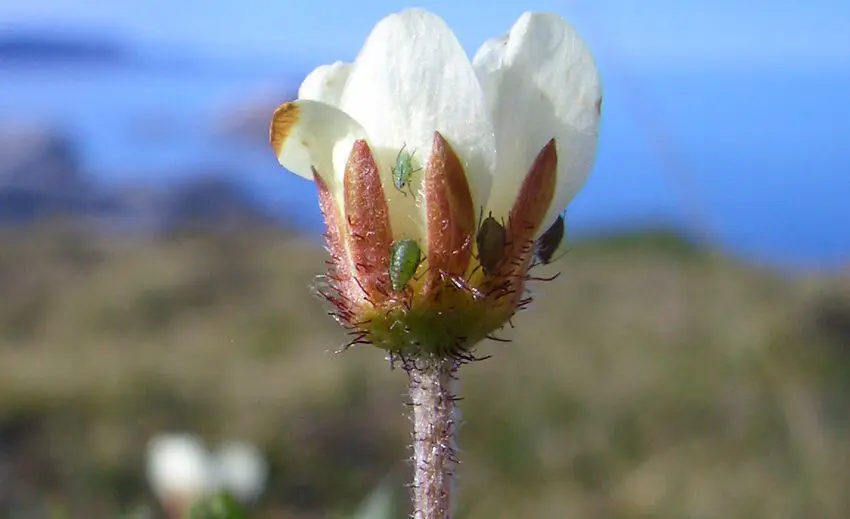Climate change “squeezing” Arctic animals and plants: new circumpolar report

The endemic aphid Acyrthosiphon svalbardicum feeding on the flowering shoots of Mountain Avens (Dryas octopetala). Photo: Steve Coulson/UNIS.
Top image: The endemic aphid Acyrthosiphon svalbardicum feeding on the flowering shoots of Mountain Avens (Dryas octopetala). Photo: Steve Coulson/UNIS.
Arctic plants, insects, birds, and land mammals are experiencing wide ranging and diverse effects from climate change. The timing of key life events, changing habitats, introduction of new predators and potentially new diseases are among the impacts described in a new report based on long-term biodiversity monitoring from around the Arctic. UNIS professor Steve Coulson has participated in writing the report released today.
20 May 2021
Press release from the Arctic Council’s Conservation of Arctic Flora and Fauna Working Group (CAFF) and The University Centre in Svalbard.
The State of the Arctic Terrestrial Biodiversity Report provides the most comprehensive circumpolar synthesis of the state of knowledge about biodiversity on Arctic lands. Dozens of experts from across the Arctic produced the report under the Circumpolar Biodiversity Monitoring Program (CBMP), the cornerstone program of the Arctic Council’s Conservation of Arctic Flora and Fauna Working Group (CAFF).
“The report is based on 15 scientific papers and the aim of the report is to identify what do we know about biodiversity, what is the current status and also how we should monitor biodiversity in the Arctic in the future”, professor Steve Coulson explains.
Professor Coulson has been involved in the report work for the last two years, being a member in the arthropod working group. Arthropods species include insects, arachnids, crustaceans and myriapods.
Changing frequency, intensity, and timing of extreme weather events such as winter rain and thaws make it hard for some species such as reindeer to access food. The effects of such incidents on wildlife populations are unknown at this time.
Need long time-series
Professor Steve Coulson says there is still a lot we do not know about the arthropods in the high Arctic.
“Two locations in Greenland in addition to the Kongsfjorden and Isfjorden in Svalbard are the only areas where we have detailed knowledge about these species. In Svalbard there are no long time-series data, so it is hard to detect changes in populations and species over time. There can be enormous changes in interannual variations of invertebrate species, but we just don’t know yet how much.”
The only longer time-series existing is from Greenland and based on these datasets one can see decline in number of species present over years. For example, there is an 80% decrease in the fly species Spilagona at the Zackenberg research station in north-eastern Greenland. Spilagona is a group that is apparently important for pollination in Greenland and probably in Svalbard, according to professor Coulson.
“We know there are big changes, due to temperature but also due to hydrology – changes in these two climate factors will lead to changes in habitat and thus lead to huge changes in population”, he says.
In Svalbard there is still a lack of long-time monitoring programmes, but UNIS and the Norwegian Polar Institute (NPI) have started to remedy this by establishing monitoring programs as part of larger research projects.
“At UNIS, the Bjørndalen Integrated Gradients project (BIG) has now on-going activities which include collection of invertebrates on a weekly basis and automated monitoring of plant phenology and plant-pollinator interactions with time-lapse cameras”, Coulson explains.
NPI has through the Fram Centre project COAT hired a technician based in Ny-Ålesund to do invertebrate sampling over time.
However, there are thousands of arthropod species and there is a need to establish a framework for monitoring, such as which species to monitor and what habitats to monitor across the Arctic.
Therefor, the biodiversity report is an important step – in order to highlight the need for more long-term monitoring of these insects and invertebrates.
The report also describes the status of terrestrial biodiversity monitoring around the Arctic, highlighting ways to improve detection and reporting on significant changes in the Arctic. The report calls for better coordination, standardization of methods, and improved use of Indigenous Knowledge, Local Knowledge, and citizen science.
The report can be downloaded from the CAFF website: https://www.caff.is/arctic-council-ministerial-may-2021